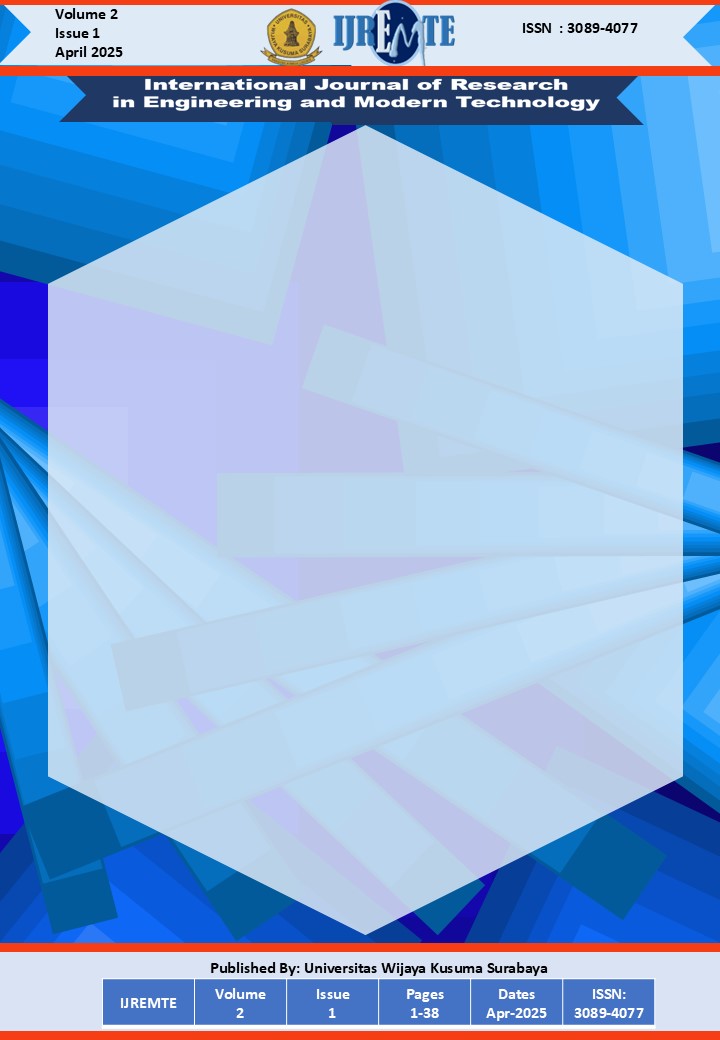Comparison of Green Building Implementation in Surabaya and Johor Baru
DOI:
https://doi.org/10.30742/ijremte.v2i1.11Keywords:
Green Building; Energy Efficiency; Sustainable Materials; EDGE Certification; Construction PolicyAbstract
The implementation of the green building concept is a strategic effort to promote sustainable development, particularly in office buildings, which are known for their high energy consumption. This study aims to evaluate the application of green building principles in office buildings located in Surabaya, Indonesia, and Johor Bahru, Malaysia, and to identify the key features, barriers, and solutions related to the adoption of Green Building Materials (GBM). A qualitative descriptive and evaluative approach was employed, guided by the EDGE (Excellence in Design for Greater Efficiencies) and Greenship standards from the Green Building Council Indonesia (GBCI). The analysis of the case study in Surabaya revealed energy savings of 16.63%, water savings of 34.79%, and material savings of 92%. With recommended improvements, energy savings increased to 23.84%, exceeding the EDGE minimum threshold of 20%. In Johor Bahru, the most important GBM features identified were energy efficiency, low carbon emissions, and recyclable materials. Major barriers included high costs, lack of awareness, and insufficient regulatory frameworks. Recommended solutions involve cost subsidies for key materials (e.g., sustainable bricks, lightweight concrete, and wood flooring), mandatory training for construction workers, and the integration of sustainability-related content into higher education curricula. The findings highlight the critical role of collaboration among government bodies, construction industry stakeholders, and educational institutions in advancing green building practices. This study contributes to the formulation of policies and strategic initiatives aimed at fostering environmentally responsible construction in Southeast Asia.
References
UNFCCC, “United Nations Kyoto Protocol,” pp. 1–24, 1997.
UNFCCC, “Doha Amendment to the Kyoto Protocol,” Unfccc, p. 41, 2012, [Online]. Available: https://unfccc.int/kyoto_protocol/doha_amendment/items/7362.php%5Cnhttps://treaties.un.org/doc/Publication/CN/2012/CN.718.2012-Eng.pdf.
P. R. Indonesia, “Undang-Undang Republik Indonesia Nomor 17 Tahun 2004 Tentang Pengesahan Kuoto Protocol to the united nations framewrok convention on climate change,” Nasional, pp. 1– 6, 2004.
O. Golubchikov and A. Badyina, Sustainable Housing for Sustainable Cities, no. October. 2012.
IEA and UNEP, 2019 Global Status Report for Buildings and Construction: Towards a zero- emissions, efficient and resilient buildings and constructi on sector, vol. 224. 2019.
ASHRAE, “ASHRAE Technical FAQ 92: What are the recommended indoor temperature and humidity levels for homes?,” pp. 1–2, 2013, [Online]. Available: https://www.ashrae.org/File Library/Technical Resources/Technical FAQs/TC-02.01-FAQ-92.pdf.
T. H. Karyono, “Arsitektur, kenyamanan termal dan energi,” no. November, pp. 1–5, 1996, [Online]. Available: https://www.researchgate.net/publication/305186728.
S. C. Lee and M. Chang, “Indoor and outdoor air quality investigation at schools in Hong Kong,”Chemosphere, vol. 41, no. 1–2, pp. 109–113, 2000, doi: 10.1016/S0045-6535(99)00396-3.
T. H. Karyono, “Bangunan hemat energi,” no. 8, p. 40561, 2016.
J. J. Randolph, “A guide to writing the dissertation literature review,” Pract. Assessment, Res. Eval., vol. 14, no. 13, 2009.
Y. H. Prasetyo, “DAN PENGUKURAN LAPANGAN STUDI KASUS : BANGUNAN KONVENSI GRHA WIKSA PRANITI BANDUNG Building Performance of Passive Design Based on Ecotect Simulation and Field Measurement Case Study : Convention Center Building Grha Wiksa Praniti Bandung,” vol. 9, no. 1, pp. 41–53, 2014.
Y. H. Prasetyo et al., “NUSANTARA DALAM REGIONALISME Tropic Climate Form of Nusantara Traditional Architecture ’ s Expression in Regionalism,” vol. 12, no. 2, pp. 80–93, 2017.
E. I. Santoso, “KENYAMANAN TERMAL INDOOR PADA BANGUNAN DI DAERAH BERIKLIM TROPIS LEMBAB,” pp. 13–19, 1982.
K. M. Al-Obaidi, M. Ismail, and A. M. Abdul Rahman, “Passive cooling techniques through reflective and radiative roofs in tropical houses in Southeast Asia: A literature review,” Front. Archit. Res., vol. 3, no. 3, pp. 283–297, 2014, doi: 10.1016/j.foar.2014.06.002.
S. Kim, P. A. Zadeh, S. Staub-French, T. Froese, and B. T. Cavka, “Assessment of the Impact of Window Size, Position and Orientation on Building Energy Load Using BIM,” Procedia Eng., vol. 145, no. December, pp. 1424–1431, 2016, doi: 10.1016/j.proeng.2016.04.179.
M. Kolokotroni et al., “Cool roofs: High tech low cost solution for energy efficiency and thermal comfort in low rise low income houses in high solar radiation countries,” Energy Build., vol. 176, no. July, pp. 58–70, 2018, doi: 10.1016/j.enbuild.2018.07.005.
W. Rattanongphisat and W. Rordprapat, “Strategy for energy efficient buildings in tropical climate,” Energy Procedia, vol. 52, pp. 10–17, 2014, doi: 10.1016/j.egypro.2014.07.049.
H. Truong and A. M. Garvie, “Chifley Passive House : A Case Study in Energy Efficiency and Comfort ScienceDirect ScienceDirect ScienceDirect ScienceDirect Chifley Passive House : A Case Study in Energy Efficiency and Comfort Chifley Passive House : A Case Study in Energy Efficiency a,” Energy Procedia, vol. 121, no. June, pp. 214–221, 2019, doi: 10.1016/j.egypro.2017.08.020.
E. Perlova, M. Platonova, A. Gorshkov, and X. Rakova, “Concept project of zero energy building,”
Procedia Eng., vol. 100, no. January, pp. 1505–1514, 2015, doi: 10.1016/j.proeng.2015.01.522.
U. C. Shin, “An empirical study of performance characteristics of BIPV ( Building Integrated Photovoltaic ) system for the realization of zero energy building q,” Energy, vol. 66, pp. 25–34, 2014, doi: 10.1016/j.energy.2013.08.012.
A. N. Sadeghifam, S. M. Zahraee, M. M. Meynagh, and I. Kiani, “Combined use of design of experiment and dynamic building simulation in assessment of energy efficiency in tropical residential buildings,” Energy Build., vol. 86, pp. 525–533, 2015, doi: 10.1016/j.enbuild.2014.10.052.
Y. Zhang, J. Kang, and H. Jin, “A review of green building development in China from the perspective of energy saving,” Energies, vol. 11, no. 2, 2018, doi: 10.3390/en11020334.
F. Shi, S. Wang, J. Huang, and X. Hong, “Design strategies and energy performance of a net-zero energy house based on natural philosophy,” J. Asian Archit. Build. Eng., vol. 19, no. 1, pp. 1–15, 2020, doi: 10.1080/13467581.2019.169620



